The Art of the Metal Album Cover: Visuals that Defined a Genre
Introduction
Album art in the world of heavy metal is not just a visual accompaniment to the music; it is a vital extension of the genre’s identity. From the ominous and intricate design that graced the covers of Iron Maiden’s “The Number of the Beast” to the bold, modern aesthetics of recent releases, metal album covers have played a crucial role in shaping the genre’s culture and appeal. This synopsis explores the history and significance of metal album art, delving into its evolution and the impact it has had on both the music and its fans. By analyzing iconic covers, we uncover the stories behind these visuals and their contributions to the broader narrative of metal.
For anyone like me a teen of the 80’s, album cover was a reason I would make a purchase of a album. Sometime not even knowing anything about the band or the music. Just thinking this looks cool or this looks metal. So it must be good. (It wasn’t always). This was back before internet of course so you couldn’t just listen to anything so you or me specifically took chances. Living in small town Ontario, Canada with not much of a record store, before I had a car I would hop a bus and go to London or Toronto to the bigger records stores and come with with 3 or 4 albums. Which back then was a lot of money when you didn’t have a lot of money. Used to spend so much time just looking at every album cover. And then when I got home you would put the vinyl on and either examine the cover, read the lyrics or if I look back to my first metal album, The Number Of The Beast it came with a order form for merchandise so I ordered my first metal shirt.
The Evolution of Metal Album Art
The roots of metal album art can be traced back to the early days of rock and roll, where artists like Led Zeppelin and Black Sabbath began experimenting with darker, more provocative imagery.
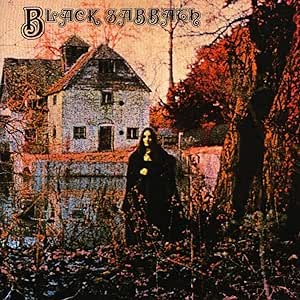
Black Sabbath’s self-titled debut album in 1970 is often cited as one of the first Metal records to feature a cover that truly captured the dark, ominous essence of the music. The eerie photograph of a cloaked figure standing in front of a dilapidated building was a stark contrast to the colorful and psychedelic covers of the era, signaling a shift towards something darker, heavier, and more menacing.This shift was crucial in establishing Metal’s identity, not just as a musical genre, but as a cultural movement.
Or you look at Led Zeppelin‘s 4th album and the cover has no writing at all on it. Not even the band name. As Zep was becoming huge and they demanded to do things their own way. The record label was not happy but they didn’t back down.
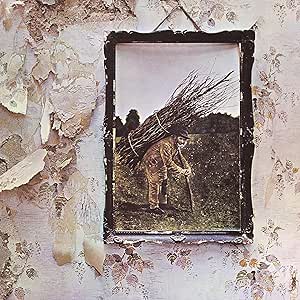
Metal album art has evolved significantly since the genre’s inception in the late 1960s and early 1970s. Early metal bands, drawing inspiration from hard rock and blues, often featured simplistic designs, with a focus on the band’s logo or a symbolic image. However, as the genre grew more aggressive and complex, so too did the album art. The 1980s marked a turning point, with bands like Iron Maiden, Judas Priest, and Metallica pushing the boundaries of album cover design.
The rise of heavy metal in the 1980s coincided with advancements in graphic design technology, allowing artists to create more detailed and elaborate covers.

One of the most influential artists of this time was Derek Riggs, the mastermind behind Iron Maiden’s legendary mascot, Eddie. Eddie quickly became synonymous with the band, appearing on almost every album cover and becoming a symbol of the band’s rebellious and often supernatural themes. Riggs’ artwork for The Number of the Beast (1982) remains one of the most recognizable covers in metal history, depicting Eddie as a puppet master controlling a devil, who in turn manipulates a smaller Eddie figure—a brilliant visual metaphor for the album’s themes of control, evil, and the human condition.
Iconic Metal Album Covers and Their Impact
Another significant example is Metallica‘s “Master of Puppets” (1986), which depicted a grim, battle-scarred cemetery with crosses connected by strings like marionettes. This image, designed by Metallica and Peter Mensch, visually encapsulated the album’s themes of control and manipulation, reinforcing the band’s message through powerful visual storytelling.

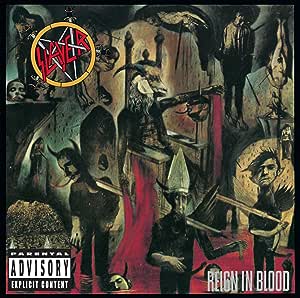
The album cover for Slayer‘s “Reign in Blood” (1986) is yet another iconic image that helped define the genre. The chaotic, hellish landscape created by Larry Carroll perfectly matched the band’s brutal sound, making the cover a lasting representation of the extreme nature of thrash metal.
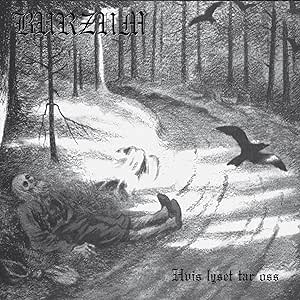
In the realm of black metal, Burzum‘s “Hvis Lyset Tar Oss” (1994) stands out for its minimalistic yet haunting imagery. The cover, featuring a desolate, fog-shrouded landscape, mirrored the cold, bleak soundscapes of the music, establishing a visual template for many black metal albums that followed.
These iconic covers did more than just sell albums; they created lasting visual identities for the bands and solidified their place in metal history. They also influenced countless other bands and artists, setting trends that would be emulated and reinterpreted across the genre.
The Role of Album Art in Metal Subgenres
Metal is a genre with numerous subgenres, each with its own unique visual language. The album art associated with these subgenres often reflects the thematic and sonic elements that define them. For instance, death metal, with its brutal and visceral sound, frequently features grotesque and graphic imagery. Covers like Cannibal Corpse‘s “Butchered at Birth” (1991) are infamous for their shocking and controversial artwork, which has become synonymous with the subgenre’s confrontational ethos.
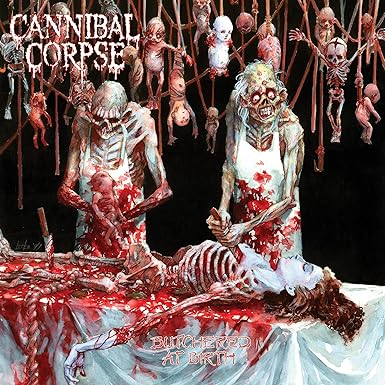
In contrast, the album art of progressive metal bands like Opeth and Dream Theater tends to be more abstract and conceptual, often incorporating surreal landscapes and intricate designs that reflect the complexity of the music. Opeth’s “Blackwater Park“ (2001), with its haunting and ethereal cover art, exemplifies this approach, inviting listeners into a world of melancholy and introspection. Black metal, as mentioned earlier, often features monochromatic, minimalist covers that convey a sense of coldness and desolation. This visual style reinforces the genre’s themes of isolation, darkness, and anti-religious sentiment, as seen in albums like Darkthrone‘s *”Transilvanian Hunger“* (1994). These visual styles are not just decorative but serve to deepen the listener’s connection to the music, creating a cohesive artistic experience that goes beyond sound.
The Role of Humour in Metal Album Art (“It’s like, how much more black could this be? And the answer is none. None more black.” )
While metal is often associated with darkness and seriousness, humour has also played a significant role in the genre’s visual identity. Many bands use humour, irony, or outright absurdity to create memorable album covers that stand out in a sea of grim imagery.
For example, Spinal Tap’s Smell the Glove (1982) is a parody of the excessive, often ridiculous album covers of the time. Though fictional, Spinal Tap’s over-the-top visual style pokes fun at the metal world, reflecting the genre’s capacity for self-awareness and satire.
Or bands like Tankard with their unique album covers that are very detailed and just fun to look at.


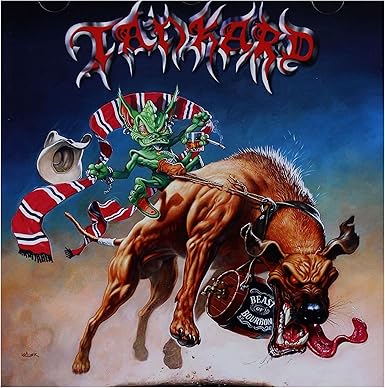
The Influence of Metal Album Art on Popular Culture
The influence of metal album art extends far beyond the music itself, permeating various aspects of popular culture. The bold, often controversial imagery associated with metal has inspired fashion, film, and graphic design. For example, the imagery of Iron Maiden‘s Eddie has become a staple in heavy metal fashion, with the character appearing on countless T-shirts, posters, and other merchandise. Metal album art has also influenced the aesthetics of horror films, video games, and comic books, where the dark and fantastical elements of metal’s visual language find a natural home. The collaboration between metal bands and visual artists has resulted in a cross-pollination of ideas, with each medium borrowing from the other to create a rich and dynamic cultural landscape.
Today, album covers must stand out on small screens and be instantly recognizable in a crowded marketplace. This has led to a trend towards simpler, more iconic designs that are easily scalable and memorable. However, the essence of metal album art—its boldness, its ability to tell a story, and its deep connection to the music—remains unchanged.
Artists and bands now often use their album art across various digital platforms, creating a cohesive visual identity that extends beyond just the cover. Social media profiles, merchandise, and promotional materials all feature these designs, making them a key part of the band’s brand.
Conclusion
The art of the metal album cover is a testament to the genre’s deep connection between sound and vision. Over the decades, these covers have not only defined the aesthetic of metal but also contributed to its cultural impact, influencing everything from fashion to film. By exploring the history and significance of these visuals, we gain a deeper appreciation for the artistry that goes into creating an album cover that resonates with fans and stands the test of time. The legacy of metal album art continues to evolve, shaping the genre’s identity and inspiring new generations of artists and musicians.
By: Blake Mossey